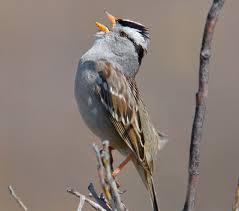 A common winter visitor is the White-crowned Sparrow. This bird nests all over northern North America and the western mountains, wintering in most of the lower 48 states and Mexico. It’s a common bird at bird feeders and in grassy and shrubby areas. The black and white striped head is distinctive although the immature have buff and brown head stripes. They feed mainly on seeds in the winter but will take worms and insects when available. You will usually find them in flocks, often with Golden-crowned Sparrows and Dark-eyed Juncos. When frightened or in bad weather you will find them looking for dense shrubbery. White –crowned Sparrows, because of their abundance an wide range, have been studied extensively.
A common winter visitor is the White-crowned Sparrow. This bird nests all over northern North America and the western mountains, wintering in most of the lower 48 states and Mexico. It’s a common bird at bird feeders and in grassy and shrubby areas. The black and white striped head is distinctive although the immature have buff and brown head stripes. They feed mainly on seeds in the winter but will take worms and insects when available. You will usually find them in flocks, often with Golden-crowned Sparrows and Dark-eyed Juncos. When frightened or in bad weather you will find them looking for dense shrubbery. White –crowned Sparrows, because of their abundance an wide range, have been studied extensively.
Like many migrants, White-crowned Sparrows travel day and night, perhaps covering 300 miles a day. Alaskan White-crowned Sparrows migrate 2600 miles to southern California. Interestingly, the birds can travel at night and feed during the day with only three hours of sleep. Experiments with caged birds show that they can perform simple tasks with no decline in performance with less than one-third of their usual sleep time. If scientists can figure out how the sparrows do it, the results might be helpful to drivers, pilots, or others who experience fatigue on the job.
Well, if that isn’t fantastic enough, in 2008 a White-crowned Sparrow got lost, flew 3000 miles across the Atlantic and landed in Norfolk, England. The “twitchers” (British for avid birdwatchers) were so impressed, that they raised funds to create a stained glass window for their local church to commemorate the event.
The song of White-crowned Sparrows has also been studied extensively; hear it here. Observations on song have demonstrated that young sparrows are born with a basic framework of their natural song but they don’t develop the full song until they listen to adults sing the next spring, nine months or so after they hatch. If they are isolated in captivity they never attain the full song and develop an odd song, depending on what they hear after that nine-month gap. They might incorporate pieces of the song of a thrush or robin if that’s what they hear! Since the young birds migrate back to where they were born, they learn the song of their parents’ population, and birds a few miles away learn the song of their parents’ population. Given the variation in song, the two groups often have different accents, just like humans do and the birds on the edges of these populations often learn each other’s dialects so they can communicate.
Research into how cities, particularly human noise in cities, changes the way White-crowned Sparrows communicate could have larger implications for how species exist in urban settings. And lots more studies on the song of the White-crowned Sparrow are abstracted here from sciencedirect.com.
In addition to the sleep deprivation and song studies, it has been discovered that major changes take place in the sparrow’s brain at the end of breeding season. The part of the brain that controls song shrinks drastically in a period of only twelve hours and the part of the brain that controls migration expands, due to hormonal changes. If scientists can figure out how to expand and shrink certain areas of the brain, White-crowned Sparrows might make us smarter!